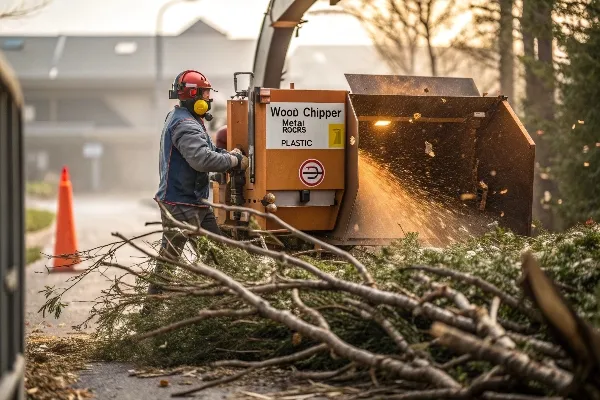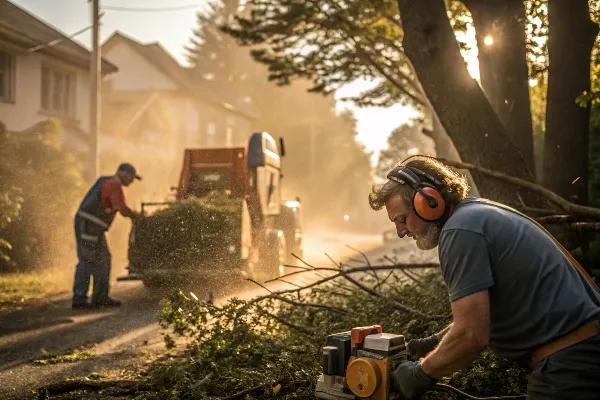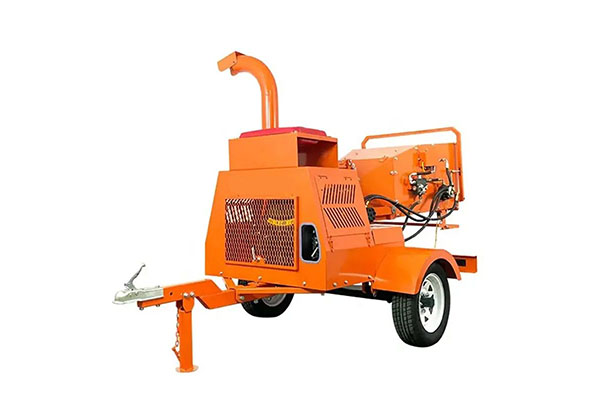Avoid your inquiry is delay response, please enter your WhatsApp/Skype along with the message, so we can contact you at the very first time.
We will reply you within 24 hours. If for urgent case, please add WhatsApp/WeChat: +8613791936882 ,. Or call +86-18678911083 directly.
I see people worry about wood chippers all the time. They picture fast-moving blades, loud engines, and flying pieces of debris. They feel nervous about potential accidents.
Wood chippers are safe when used correctly. They have emergency bars and sturdy guards to prevent accidents. Regular maintenance, operator training, and protective gear reduce risks. Following instructions and being cautious also help.

Wood chipper safety
I remember my first time operating a wood chipper. I felt tense because I had heard stories about rocks smashing blades or branches kicking back. Then I realized proper technique and safety features protect me. I saw the importance of reading manuals, wearing eye protection, and keeping bystanders away. Let me explain more, so you can understand why these machines can be safe when handled with care.
I often see people toss random items into a chipper. That can be dangerous. Rocks, metal, or plastic can break the machine or injure the operator.
Avoid loading any non-wood materials like stones, metal parts, or plastic into a chipper. Those items damage components and create dangerous projectiles. Stick to branches, trunks, and similar yard debris.

What you cannot put in a wood chipper
I learned the hard way that feeding foreign objects into a chipper can result in costly repairs or serious injuries. The machine is designed to handle organic matter, such as branches and small tree trunks. Let me break down why certain things should never go through this kind of equipment:
• Metal fragments: I vividly recall a story I heard when someone accidentally fed wire or nails through a wood chipper. That metal jammed the blades, sparked, and caused catastrophic damage to the engine. The sudden force could also knock debris back at the operator.
• Plastics and glass: I once saw a person try to shred plastic packaging. The plastic did not chip the same way as wood. It caused friction and small molten flakes shot out of the chute. Besides damaging the chipper, it also posed environmental concerns. Glass fragments behave similarly, often leading to shattered pieces flying in unpredictable directions.
• Rocks or gravel: These materials quickly wear down or break the blades. Chipper blades are razor-sharp, but they are not made to crush stones. In my experience, even small pebbles create big problems. They can ricochet around the feed chute and cause harm.
• Pressure-treated lumber or painted wood: This type of wood often contains chemicals. When shredded, those chemicals can release into the air or become part of the mulch. That can be dangerous if used in gardens or around pets.
Below is a short table showing why certain items should not enter a wood chipper:
| Item | Why It’s Dangerous |
|---|---|
| Metal (nails, wire) | Can damage blades, cause sparks, and risk operator safety |
| Plastics | Does not chip well, can melt, or create pollutants |
| Rocks or gravel | Can break blades and become deadly projectiles |
| Painted/treated lumber | Chemicals may release, harmful to the environment and operators |
| Glass | Shatters unpredictably, sends shards flying at high speed |
I remember my own surprise when I first learned how sensitive chippers are to foreign objects. The risk is not always obvious, because it looks like a tough machine. However, if you read the operator’s manual, you see warnings about non-wood materials. Most machines have safety bars and a feed chute design that tries to reduce the chance of severe kickback.
Still, the best way is to handle trimming carefully. Sort through your debris pile. Remove large rocks, nails, or synthetic materials. If you respect these limits, you keep the device operational for years. That also prevents you from facing expensive repairs or hurting people who might be nearby. In my view, it is better to stay on the safe side. A wood chipper is a powerful tool, but it is not a garbage disposal. I maintain a separate bin for real trash, and that helps me avoid confusion. As soon as I started following those steps, I felt more secure.
I sometimes stand near a wood chipper and flinch at the noise level. The engine roars. The blades whir. Neighbors cover their ears. People ask if there is a quieter model.
Wood chippers produce loud sounds due to heavy-duty engines and fast-rotating blades. The grinding process generates high decibels. Proper ear protection and distance help reduce hearing risks.

wood chipper noise
Noise is a major concern for many of us who work around wood chippers1. I recall struggling with complaints from neighbors when I ran a chipper in my yard. That loud clatter came from a powerful gas engine, combined with the strong impact of spinning blades ripping through chunks of wood. This mechanical process creates vibrations and friction that naturally lead to significant sound output. Let me clarify the main reasons.
First, the engine is designed to deliver a lot of torque. It needs enough power to force logs and branches through the blades, even if the wood is dense or twisted. That engine, often running at high RPMs, produces a constant roar. Different engines have different noise levels. However, chippers in general use industrial-grade motors that exceed the volume of most lawn equipment.
Second, the presence of sharp, fast-rotating blades contributes to the noise. Those blades contact the wood at high speed, often thousands of revolutions per minute. When the wood hits those edges, the resulting impact is loud. The repeated contact between wood and blade occurs many times in a few seconds, creating a grinding or shredding sound that can echo around the work site. In addition, the internal metal parts vibrate under stress, which can boost decibel levels.
Third, the discharge system typically forces chips out at high speed. The airflow and expelled chips produce extra racket. The chipper’s design channels shredded material through a chute, using either mechanical or airflow-driven means. Air rushing through the chute plus chunks of wood colliding with metal surfaces generate more noise. I sometimes see padded or insulated chutes, but the improvement is still modest. The overall mechanism is inherently loud.
I have tried strategies to reduce the noise problem. I wear ear protection2, such as noise-canceling earmuffs, which helps maintain my hearing over time. I also speak with neighbors before starting a chipping session. I schedule daytime hours when possible, so that the disturbance is minimal. Wood chippers are not silent machines, but being considerate can help prevent conflicts. I also like to check if local regulations limit allowable noise levels.
Noise concerns can drive some people to rent smaller electric models. Electric chippers can be quieter, but they are also less powerful. For bigger tasks, gas-powered chippers remain the main tool. That is why we accept the loud environment as part of the job. Planning around noise is key. For instance, I advise operators to wear protective gear and keep a safe zone around the chipper. That means not only for debris but also for the noise exposure. I place warning signs telling bystanders to stand back. With the right practices, I can manage the noise challenge while still using this powerful machine.
I see people worry about chipping wet branches after a rainstorm. They wonder if the moisture will clog the machine or reduce the quality of the mulch. They also worry about damaging the chipper.
You can usually feed wet wood into a chipper. However, wet material can be heavier and more likely to compress inside the chute. Slow down your feed rate and watch for clogs.

Chipping wet wood
I remember the first time I tried to chip wood on a rainy afternoon. The logs were damp, and the branches had water droplets. I felt uncertain if this setup would work or if I might jam the blades. I discovered that wet wood can indeed be chipped, but I had to take extra care to prevent clogs and buildup.
First, the moisture in the wood adds weight. That extra weight puts more load on the chipper’s engine. I noticed the engine ran louder and seemed to struggle a bit when I fed soggy logs. In my experience, adjusting the feed rate helps. I recommend feeding the material slower, to allow the blades time to cut each piece thoroughly. If I shove too much wet wood in at once, the high moisture content can cause the space around the blades to become stuck with pulpy residue. That leads to blockages.
Second, wet wood chips can clump together when exiting the machine. The water acts like a binding agent, which gathers small chips into lumps. This can create choke points in the discharge chute. When I see the chips come out in clusters instead of a steady shower, I pause. I then check inside the chute to confirm there is no significant blockage. That little bit of maintenance stops major clogs and helps me continue my task.
Third, wet blades can dull more quickly. The friction with moist debris might lead to faster blade wear if there is any grit or dirt on the branches. I keep a close watch on the blade sharpness. Dull blades increase the risk of jamming. After a big job, I inspect them. If I find chips or nicks, I get them sharpened before the next use. A severe collision with a rock or piece of metal can degrade them faster, whether the wood is wet or dry. Still, moisture plus debris can speed up the wear.
I also think about the quality of the finished product. Wet chip mulch is heavier, and it may hold more moisture. Some people like it because it can help retain water in landscaping. Others dislike it because it might invite mold if left in piles without enough ventilation. I prefer to mix wet chips with dry chips if I want a more uniform mulch. If I am using the chipped material as compost, I sometimes allow it to dry first. Then I incorporate it into my compost system more gradually.
Below is a concise table covering wet wood considerations:
| Factor | Potential Impact |
|---|---|
| Feed Rate | Slower feed needed to avoid clogging |
| Engine Strain | Heavier, moist wood demands more power |
| Blade Wear | Increased friction and possible grit accumulation |
| Discharge Clumping | Wet chips stick together, can block chute |
| Mulch Quality | Heavier, damp mulch may promote mold if not aired |
Ultimately, I have found that wet branches and logs are chippable, as long as I stay patient. If I sense the machine is straining, I pause and let it clear. I keep an eye on clogging, and I never rush the process. Also, it helps to wait until the worst of the rain has passed, so the wood is not excessively waterlogged. For me, careful observation and general maintenance are the keys to success when chipping wet wood.
Wood chippers are safe if used responsibly. They can handle many tasks, but they need proper care to avoid hazards, clogs, and excessive noise, so I trust them when I follow the rules.